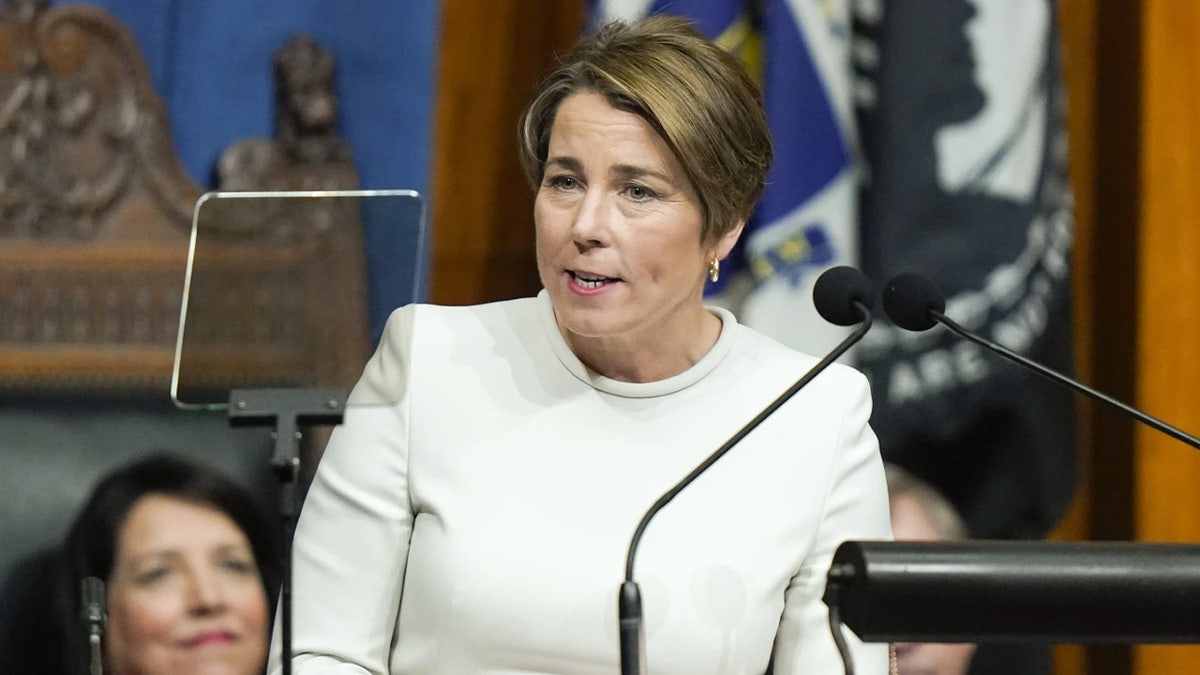Migrants sleeping on the floors of Boston’s Logan International Airport will soon be banned from doing so and Massachusetts officials are telling migrants currently at the southern border that its shelter system is out of space.
More than 100 migrants have been using the facility as a shelter — lining the floors of Boston’s main air hub with makeshift beds and air mattresses — but they will be prohibited from doing so from July 9 and instead be offered free tax-payer-funded accommodation at a former minimum-security dorm-like facility in Norfolk, Gov. Maura Healey announced Friday.
The state has refurbished Massachusetts’ Bay State Correctional Center, a former minimum-security dorm-like facility, which opened last week and can accommodate 140 migrants and homeless families, or about 450 people. The facility is located on the grounds of Massachusetts Correctional Institution (MCI), a medium-security prison.
DEMOCRATIC TOWN FURIOUS OVER MIGRANT SHELTER OPENING IN NEIGHBORHOOD

Migrants spend the night on the floor at Logan Airport. (Matt Stone/MediaNews Group/Boston Herald via Getty Images)
The migrants will also be offered transfers to other new “safety-net” sites, the Healey administration said.
“The administration has worked diligently in recent months to increase the number of families leaving shelter into more stable housing,” the state’s emergency assistance director, Scott Rice, said in a statement.
“With this progress… we are now in a position to end the practice of families staying overnight in the airport. This is in the best interest of families and travelers and staff at Logan, as the airport is not an appropriate place for people to seek shelter.”
Norfolk has a population of about 11,500 and some residents fumed last month when they heard about the facility being turned into a migrant shelter. The town voted heavily in favor of President Joe Biden in 2020.
The move comes after the administration says it sent a state delegation to the border to tell border officials, NGOs and migrants that Massachusetts is out of shelter space.
MIGRANTS CONTINUE TO STREAM INTO BOSTON AIRPORT AS MORE THAN 100 SLEEP ON THE FLOOR

The migrants are to be offered free tax-payer-funded accommodation at a former minimum-security dorm-like facility in Norfolk. (Google Maps)
The Healy administration says it is also putting out flyers in English, Spanish and Haitian-Creole to let new migrants know that they will have to plan for housing in Massachusetts that does not include Logan Airport or the state’s shelter system.
Healey last summer declared a state of emergency over the surge of migrants into the state and the Bay State has struggled to get a grip on the crisis. The state has previously said that it is obliged to cater to the migrants because of its 1983 sanctuary city law which was passed to deal with the relatively small number of homeless families and pregnant women, although critics have said the law does not apply to migrants who are not U.S. citizens.
The administration said Friday it has been increasing its efforts to provide migrants with housing assistance, work authorization applications, job placements and English classes.
As a result, more than 300 families have left the facilities since May, the administration said.
These numbers are expected to increase as the administration implements a nine-month length of stay limit for emergency shelters, which was passed by the Legislature and was signed by Healey. She also implemented 30-day engagement requirements, where migrants have to demonstrate they are taking action toward getting work permits, jobs and housing.

Massachusetts Gov. Maura Healey delivers her inaugural address in the House Chamber at the Statehouse on Jan. 5, 2023, in Boston. She has announced migrants will no longer be allowed to stay at Logan Airport. (AP Photo/Steven Senne)
Rice told Fox News Digital last month that families at the Norfolk site will have access to showers and bathrooms on each floor. The facility also has a cafeteria, a gymnasium, a large common room and offices that will be used for case management and administrative activities.
Rice added that play areas for children were being set up along with classroom spaces for adults to learn English and get job training.
The site is staffed 24/7 by a contracted service provider and families are provided with transportation on and off site. The razor wire on the fence surrounding the facility was removed and the gates are to remain open, so families are free to exit and return as needed, the governor’s office says.
It is unclear how much the entire operation will cost the taxpayer.


























































